15 Essential Mobility Exercises For Runners
Reduced mobility of the joints leads to an incomplete range of motion, which then results in a poor running form.
To prevent this and to warm up properly before an activity, include mobility exercises for runners in your training plan.
In this article, I will show you all the mobility exercises for runners that I do myself and I will answer the most common questions.
What is mobility?
Mobility is the ability to achieve maximum range of motion (ROM) of the entire muscle group around joints. The more flexible the surrounding muscles and tendons, the more mobile joints are. The ability to have a wide range of motion will ensure better mobility and reduce the risk of injury.
If you want to improve your performance, running form, and reduce your risk of injury, check out these 15 mobility exercises for runners and include them in your training plan.
Mobility exercises for runners
Mobility exercises prepare joints for activities that require better mobility or cause more burden than everyday movements.
Joint rotations lubricate joint cartilages and help the secretion of more synovial fluid, which reduces friction and makes movement easier.
Mobility exercises for runners are designed to improve the functional range of motion of your joints while increasing muscle strength and flexibility.
1. Neck rotation
Neck rotation is an exercise that improves neck mobility and helps remove pain and stiffness in the neck while stretching neck muscles.

How to properly do neck rotation?
- Start by standing with your feet hip-distance apart, look straight ahead, and put your hands on your hips to keep your upper body straight.
- Turn your neck left and look over your left shoulder, then turn right and look over your right shoulder. Repeat the motion 5 times.
- Bend your neck forward, then side to side. Repeat the motion 5 times.
- Bend your head left, then right, Repeat the motion 5 times.
Tips for properly doing neck rotation
- Maintain your posture – keep your upper body straight, do not turn as you perform the exercise.
- As you bend your head side to side, do not raise your shoulders, keep them relaxed.
- Perform the exercise within the limits of comfort – do not make any sudden movements.
2. Arm circles
Arm circles is an exercise that improves shoulder mobility by stretching and strengthening the muscles of the shoulder.

How to properly do arm circles?
- Start by standing with your feet hip-distance apart, look straight ahead, and keep your upper body straight.
- Raise your left arm and make circular motions.
- Make 5 circular motions in both directions.
Repeat the exercise with your other arm.
Tips for properly doing arm circles
- Maintain your posture – keep your upper body straight, do not turn as you perform the exercise.
- Perform the exercise within the limits of comfort – do not make any sudden movements.
3. Torso rotation
Torso rotation is an exercise that activates your core by stretching and strengthening the external oblique muscles, chest muscles, and back muscles.
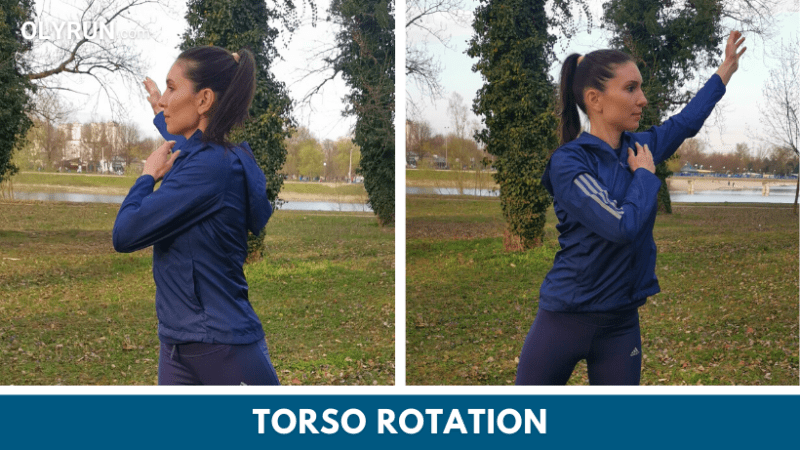
How to properly do torso rotation?
- Start by standing with your feet hip-distance apart, look straight ahead, and keep your upper body straight.
- Swing your left arm to the left, following it with your eyes. Put your right arm on the shoulder of the stretched arm.
- Swing your right arm to the right, following it with your eyes. Put your left arm on the shoulder of the stretched arm.
Repeat the motion 5-10 times.
Tips for properly doing torso rotation
- Maintain your posture – keep your upper body straight.
- Perform the exercise within the limits of comfort – do not make any sudden movements.
4. Hip circles
Hip circles are one of the hip mobility exercises that improve hip mobility while stretching lower back muscles and strengthening the core.

How to properly do hip circles?
- Begin by standing with your feet hip-distance apart, hands on your hips, look straight ahead, and keep your upper body straight.
- Move your hips in a circular motion.
Do 10 reps of circular motions in both directions.
Tips for properly doing hip circles
- Maintain your posture – keep your body straight.
- Make as large circular motions as possible with your hips – start with smaller circular motions gradually increasing the volume.
5. Straight leg swings
Straight leg swings are one of the hip mobility exercises that improve the mobility of hip flexors and extensors.
They also activate the nervous system, which prepares you for a faster run.
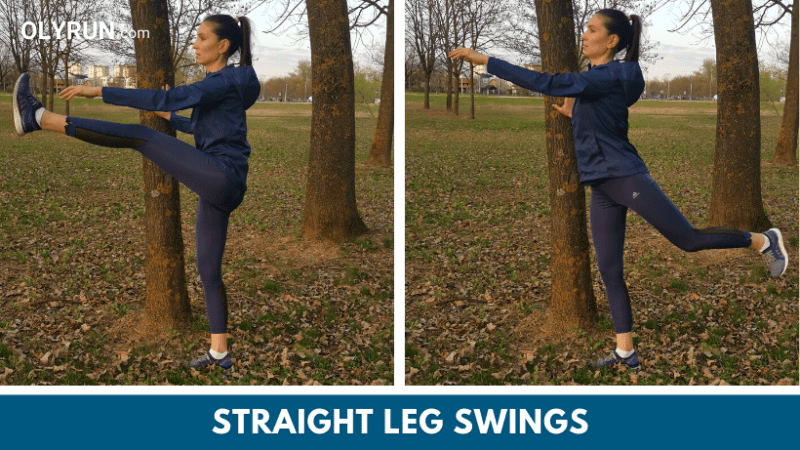
How to properly do straight leg swings?
- Stand next to your support (fence, tree, bench…) and hold it for balance during the exercise.
- Swing the left leg, stretched in the knee, forward then backward, standing fully on the right foot as you swing.
Do 10-15 reps, then repeat the exercise with the opposite leg.
Tips for properly doing straight leg swings
- Make sure you have enough space so that you can perform the full range of motion smoothly.
- Maintain your posture – keep your body straight, do not bend your back or turn your hips.
- Control your movements – avoid swinging your leg too high and avoid performing the exercise too quickly.
6. Side leg swings
Side leg swings are one of the hip mobility exercises that improve the mobility of the hip adductors and abductors.
These are the muscle groups used to move your leg toward or away from the midline of your body.

How to properly do side leg swings?
- Stand in front of your support (fence, tree, bench…) and hold it for balance during the exercise.
- Swing the left leg, stretched in the knee, to the left, and then to the right, standing fully on the right foot as you swing.
Do 10-15 reps, then repeat the exercise with the opposite leg.
Tips for properly doing side leg swings
- Make sure you have enough space so that you can perform the full range of motion smoothly.
- Maintain your posture – keep your body straight and do not bend your back.
- Control your movements – avoid swinging your leg too high and avoid performing the exercise too quickly.
7. Standing knee to chest
Standing knee to chest is one of the hip mobility exercises that improve hip mobility while increasing the flexibility of the glutes and the hamstrings.

How to properly do standing knee to chest?
- Begin by standing with your feet hip-distance apart, look straight ahead, and keep your upper body straight.
- Raise the left knee to the chest, standing fully on the right foot.
- Grab the raised knee with both hands, pulling it closer to the chest. Hold the position for 5-10 seconds.
- Slowly lower the left leg on the ground.
Do 10 reps, then repeat the exercise with the opposite leg.
Tips for properly doing standing knee to chest
- Maintain your posture – keep your body straight and do not bend your back (pull your knees towards your chest, not your chest towards your knees).
- Keep your support leg as straight as possible.
8. Heel grab
Heel grab is one of the hip mobility exercises that improve the mobility of your hips and ankles while also stretching your groin.

How to properly do heel grab?
- Begin by standing with your feet hip-distance apart, look straight ahead, and keep your upper body straight.
- Grab the left heel with both hands and pull it towards the opposite hip, standing fully on the right foot. Hold the position for 5-10 seconds.
- Slowly lower the left foot on the ground.
Do 5-10 reps alternately with each leg.
Tips for properly doing heel grab
- Maintain your posture – keep your body straight and do not bend your back.
- Keep your support leg as straight as possible.
9. Standing quad stretch
Standing quad stretch is an exercise that improves hip and ankle mobility, and stretches the quadriceps, hip flexor muscles, and the tibialis anterior.

How to properly do a standing quad stretch?
- Start by standing with your feet hip-distance apart, look straight ahead, and keep your upper body straight.
- With both of your hands, pull your left heel towards the glutes, standing fully on your right foot. Hold the position for 5-10 seconds.
- Slowly lower your left foot to the ground.
Repeat the motion 5-10 times with each leg.
Tips for properly doing standing quad stretch
- Maintain your posture – keep your upper body straight and do not bend your back.
- Make sure the whole foot of the front leg is on the ground.
- Perform the exercise within the limits of comfort – do not make any sudden movements.
10. Single leg hip rotation
Single leg hip rotation is one of the hip mobility exercises that improve hip mobility and strengthen the glutes and the hamstrings, while also activating your core.

How to properly do single leg hip rotation?
- Begin by standing with your feet hip-distance apart, look straight ahead, and keep your upper body straight.
- Lift the left knee up to the hips, standing fully on the right foot.
- Move the left leg in a circular motion.
Do 10 reps in both directions, then do the exercise with the opposite leg.
Tips for properly doing single leg hip rotation
- Maintain your posture – keep your body straight and do not bend your back.
- Keep your support leg as straight as possible.
- Use your hands to maintain balance. For additional stability, use a support to make movement control easier.
11. Deep squat stretch
The deep squat stretch is one of the hip mobility exercises that improve hip and ankle mobility by stretching your groin, quadriceps, glutes, hip adductors, and calf muscles.

How to properly do deep squat stretch?
- Begin by standing with your feet more than hip-distance apart and facing forward, look straight ahead, and keep your upper body straight.
- Get down into a deep squat. Look up and keep your core as straight as possible while keeping your elbows away from your knees.
- Hold the position for 15 seconds while pushing out with your elbows.
Tips for properly doing the deep squat stretch
- Your heels should be in contact with the ground for the duration of the exercise – if you find it difficult to maintain balance then your heels should be on an elevated surface.
- Maintain your posture – keep your body straight and do not bend your back.
- As you get down into a deep squat your knees should follow the direction of your toes – do not allow your knees to move inwards.
12. The world’s greatest stretch
The world’s greatest stretch is one of the hip mobility exercises that improve hip mobility, stretch hip flexors, and your groin while strengthening your glutes.
That allows you to have longer stride length and better movement control.
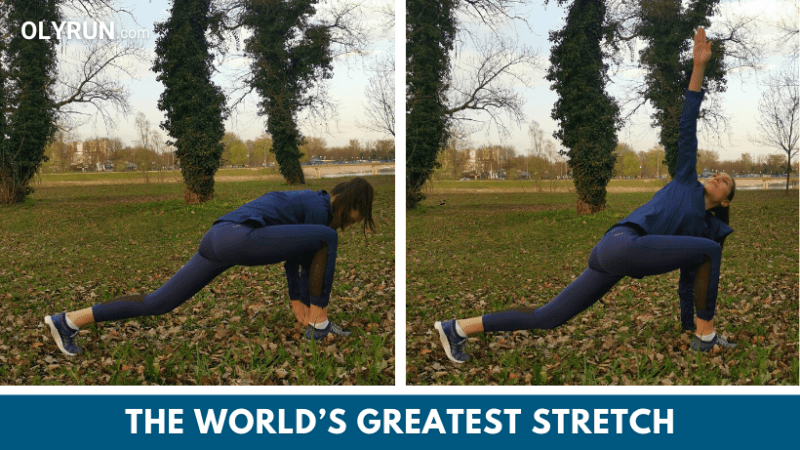
How to properly do the world’s greatest stretch?
- Begin by standing with your feet hip-distance apart, look straight ahead, and keep your upper body straight.
- Step forward with the left foot into a lunge. Put both of your palms on the ground, parallel to the left foot.
- The left elbow should be as close to the ground as possible.
- Extend the left arm upwards, following it with your eyes.
Repeat the motion 3-5 times, then repeat with the opposite side.
Tips for properly doing the world’s greatest stretch
- Maintain your posture – keep your body straight and do not bend your back.
- Make sure that your calf is perpendicular to the ground – your knee must not be in front of your foot.
- Make sure not to touch the ground with the knee of the back foot.
13. Side lunge stretch
Side lunge stretch is one of the hip mobility exercises that improve hip and ankle mobility and stretch hip flexors and your groin while strengthening hip abductors and glutes.

How to properly do a side lunge stretch?
- Begin by standing with your feet hip-distance apart, look straight ahead, and keep your upper body straight.
- Step with the left foot into a side lunge. With the right hand, gently push the stretched right leg towards the ground so that you feel a stretch in your groin.
- Hold the position for 10 seconds.
Repeat the exercise with the opposite side.
Tips for properly doing side lunge stretch
- Maintain your posture – keep your body straight, do not bend your back, and do not turn.
- Don’t let your heel lose contact with the ground while performing the exercise – without the proper range of motion in your ankle, you will be tempted to lift your heel off the ground so that you can squat deeper.
14. Dynamic calf stretch
Dynamic calf stretch is an exercise that helps improve ankle mobility by stretching the hamstrings and calves while strengthening calves, core, arm, shoulder, and feet muscles.

How to properly do dynamic calf stretch?
- Start with both of your palms and feet on the ground.
- Raise your left heel and put your right leg on the back of your left leg.
- Slowly lower your left heel towards the ground until you feel the slight tightening in your left calf muscles.
Repeat the motion 5 times and then repeat the exercise with the opposite side.
Tips for properly doing a dynamic calf stretch
- Maintain your posture – keep your body straight and do not bend your back.
15. Ankle Circles
Ankle circles is an ankle mobility exercise that relaxes the ligaments and tendons around the ankle.
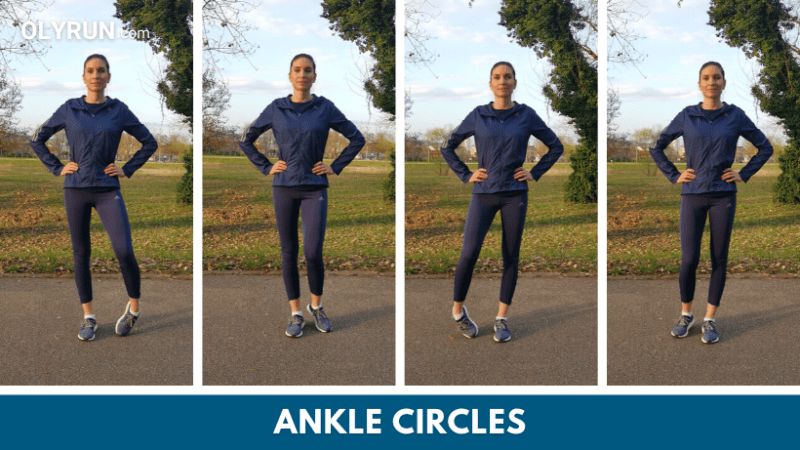
How to properly do ankle circles?
- Begin by standing with your feet hip-distance apart, look straight ahead, and keep your upper body straight.
- Do circular motions on the ankle of your left foot, leaning on your right foot.
- Do 10 circular motions in both directions.
Repeat the exercise with the other foot.
When should runners do mobility exercises?
Mobility exercises for runners should be part of your warm-up routine before training or races. They should be performed after an easy jog, as part of your mobility exercises and dynamic stretches, before the main part of your training. This way, you will prepare your joints for the upcoming exertion and reduce the risk of injury.
Read more: Warm-up Before Running [Ultimate Guide]
You can also do mobility exercises for runners after the main part of your training, as part of your cooldown. This will relax your ligaments and tendons around joints and reduce stiffness and tension.
Why is it important to do mobility exercises for runners?
Mobility exercises for runners have numerous benefits:
1. Improve joint mobility so that the body is able to perform movements properly.
2. Improve proprioception (awareness of body movement), and the way your joint behaves in conditions of imbalance. For example, if you are on an uneven surface, your body will recognize it and prevent a sprained ankle.
Research has shown that proprioceptive training is effective in preventing ankle sprains.
3. Develop strength.
Research has shown a reduced number of injuries among runners who have developed ankle strength.
On the other hand, the lack of joint mobility will result in muscle imbalance. This way, the more stable body parts become more mobile, taking over the functions of more mobile body parts, which often leads to injuries.
Who should do mobility exercises for runners?
Mobility exercises for runners should be done by all runners, whether they are beginners or advanced runners.
However, there are groups of runners who will particularly benefit from including mobility exercises in their training plan. Those are:
1. Runners who spend most of the day sitting at a desk
2. Older runners
3. Runners more susceptible to injuries
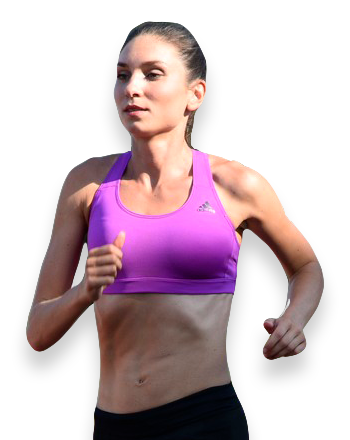
Matea Matošević
Hi, I’m Matea! I’m an Olympic Marathon Runner, founder, and writer behind OLYRUN.com. On this site, I provide help in the form of my knowledge and experience to all who love running and active living. Read more…

